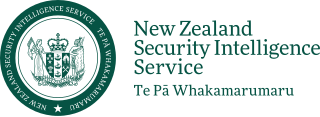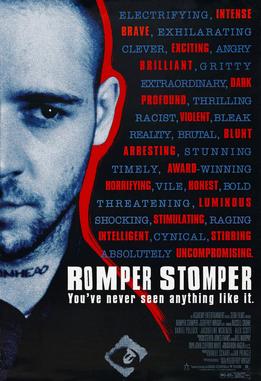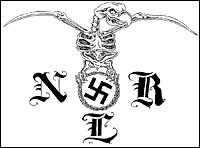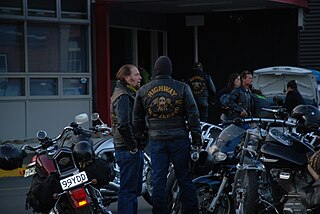| Founded | Early 1990s |
|---|---|
| Founded at | Paparua Prison, Christchurch |
| Type | White power skinhead, street gang |
Region | South Island, New Zealand |
Membership | 15 |
Key people | Aaron Howie, Neihana Foster, Ivan Gugich, Hayden McKenzie, Leighton Wilding, Shannon Brent Flewellen, Malcolm George Chaston |
The Fourth Reich was a racist skinhead prison gang formed in Paparua Prison (officially known as Christchurch Prison) in Christchurch in the early 1990s that terrorised communities in Nelson and on the West Coast of the South Island, New Zealand. [1] Largely a stand-over prison gang, the Fourth Reich garnered a reputation for extreme violence, several members having been handed down life sentences. There is little evidence to suggest that the Fourth Reich still exists either in the prison system, or in New Zealand society. [2]
The North Island of New Zealand is more ethnically diverse, while the South Island tends to have greater concentrations of Pākehā (New Zealander of European descent) communities. In virtue of this demographic feature, most racist skinhead gangs have tended to be active on the South Island. [3] The Fourth Reich was no exception in this respect, having been formed in the Paparua prison in Christchurch. The gang terrorised communities in Nelson and the West Coast of the South Island. [1]
The issue of when the gang was formed is both vague and contentious. Most sources assert that the group was formed in the early 1990s. [2] [4] Newbold, Emeritus Professor at the University of Canterbury, asserts that the group formed in 1992, while Lynch asserts that the group was co-founded in 1994 by Malcolm George Chaston. [3] [5]
According to researchers, the release of Romper Stomper in 1992 was a shot in the arm for skinhead gangs and white supremacist ideology. [2] [4] During the late 1990s and early 2000s, the Fourth Reich terrorised communities on the West Coast and in Nelson on the South Island. Practitioners throughout the New Zealand national security sector perceived that the Fourth Reich presented a credible terrorist threat to the country during the early 2000s. [2] Between 1996 and 2011, members of the Fourth Reich were charged, tried and sentenced with some of the most lengthy prison sentences in the history of modern New Zealand for crimes of shocking violence, predominantly with racist and bigoted dimensions. [3]
There is little evidence to suggest that the Fourth Reich still exists either in the prison system or in New Zealand society. [2]
According to research interviews, security practitioners in the New Zealand national security sector perceived the Fourth Reich and its members as very different to other white power skinhead groups, both those that had existed for some time in New Zealand, and those that had sprung up in the wake of the movie Romper Stomper in 1992. Whereas these other groups were engaged in criminal activities and were thought to pose a menace to society, none were thought to pose a credible terrorist threat to the nation. Fourth Reich, on the other hand, was perceived not only to be both more dangerous and racist than these other right wing extremist groups, but "considerably more ideologically driven". [2] According to one security practitioner interviewed, there was concern throughout the New Zealand security sector during the early 2000s that the Fourth Reich was planning a terrorist attack with mass casualties. Subsequent investigations failed to uncover "explicit evidence" that such a plot was planned. [2]
Whether they posed a real terrorist threat or not, Fourth Reich members were some of the most violent and dangerous criminals local police had ever come across. According to Detective Derek Shaw who investigated the gang in 1997, its members were the most ruthless he had confronted throughout his 25-year career. Detective Shaw feared for not only his own life, but for the lives of his family. At the height of the crackdown on the gang in 1998, Sergeant Greg Sparrow was forced to relocate his wife and children for two weeks after receiving a credible threat to his life. [6]
The degree to which this violence was motivated by neo-Nazi or white supremacist ideology is contentious. On the one hand, the view of practitioners in the New Zealand national security establishments was that Fourth Reich members were "considerably more ideologically driven" than those of other skinhead groups, while local police highlighted the degree to which they were motivated by hate, and the role of hate in their 'philosophy'. [6] Sociologist Jarrod Gilbert argues, given that Fourth Reich member Neihana Foster was biracially Maori (indigenous New Zealander) and Pākehā, and he and fellow gang member Aaron Howie murdered Maori rugby player Hemi Hutley because of his race, that this reflects the lack of ideological and philosophical rigors of the group. [4] In a similar vein, Addison argues that most skinhead gangs in New Zealand lack a "coherent belief system or philosophy", citing research which suggests that members of New Zealand skinhead gangs were not familiar with white supremacist ideology, instead primarily motivated by a cocktail of alienation and hate. [7]
The Fourth Reich was a relatively small and hardcore skinhead gang with approximately fifteen members. [4] [3] Not long after the gang was founded, it garnered a following in Christchurch, Nelson, Greymouth, Timaru and Dunedin. [3] Full members of the gang wore black t-shirts with the gang's logo: a large Celtic cross with a swastika at the centre. [5]
According to research conducted by Addison, members of New Zealand skinhead gangs, much like those of similar groups in England, are associated with social estrangement, abusive and deprived upbringing, low socioeconomic status, social disaffection, drug abuse and criminal deviance. This stands in stark contrast to skinheadism in the United States, where members tend to be well-adjusted, employed and socially integrated. Furthermore, American skinhead groups tend be well-organised with a "developed political consciousness". [7]
Addison's depiction of members of New Zealand skinhead gangs is certainly borne out by members of the Fourth Reich. They were opiate users and without a doubt criminally deviant. [6] Shannon Brent Flewellen's chequered and troubled youth is a case in point. Raised as the son of a drug-addict and step-son of an iwi leader and gang member who was murdered, he reportedly sought refuge under the family home as a child while gang business was conducted inside the house. [8]
An interesting feature of New Zealand skinhead gangs is that Maoris are occasionally members. This was infamously highlighted in 1991 when Neihana Foster, biracially Maori and Pākehā and visibly of Maori heritage, was charged and convicted alongside fellow Fourth Reich member for the murder of Hemi Hutley. [3] [4]
Little information is available about the organizational structure of the Fourth Reich. According to one source, Ivan Gugich was the president of the gang in 1997. [6] The literature points to Malcom George Chaston, Leighton Wilding and Ivan Gugich as co-founders of the gang. [3] [5] [6] Leighton Brent Wilding was sergeant-at-arms. [9] In 1997, an unnamed male member of the gang claimed that he had the rank of private after being beaten, stabbed and having his finger cut off by two other members of the gang. [3] [4]
As discussed above, New Zealand skinhead gangs lack the organisational structure of American skinhead groups. [7] There is no evidence to suggest that the Fourth Reich was part of a national or international organisation. Like other racist New Zealand gangs, the Fourth Reich was "transient and directionless" and this in turn affected its longevity. [3]
Although the New Zealand security sector perceived that the Fourth Reich was thought to present a credible terrorist threat during the early 2000s, the group was never investigated, charged, or tried under New Zealand's Terrorism Suppression Act of 2002. [2] [10] While the New Zealand security sector was concerned about the possibility that the Fourth Reich might commit a terrorist act with mass casualties during the same period, there is no evidence to suggest that the Act was passed expressly to deal with that particular threat. The Act was characterised by then Solicitor General David Collins as "virtually unworkable" and "almost impossible to apply in a coherent manner" in 2007 and remained unchanged in 2019 after the Christchurch mosque shootings. [11] Given the shortcomings of the Act, it is not surprising that no charges were laid under the Act. During the same period, members of the Fourth Reich were subjected to regular searches conducted by the police. [5]
By the late 1990s, members of the Fourth Reich had procured an infamous reputation as some of the most ruthless murderers on the South Island. [5] During their trial in 1997, Aaron Howie and Neihana Foster both received life sentences, after being found to have murdered Maori rugby player Hemi Hutley, then 23 years old. Hutley was beaten senseless and then dragged 125 metres to the Buller river where he was dumped and later drowned. Both of the defendants were 26 years old at the time. [3] [8] Howie cut his ties with the gang after he was released from prison.
In 1997, Ivan Gugich, then 28, and Greg Dunnill, then 24, were sentenced to eight and seven and a half years respectively. [3] The literature is contentious on what the victim actually did. According to the victim himself, Gugich and Dunnill meted out punishment because he wanted to leave the gang. Two sources assert that the real reason was that he was caught trying to steal the gang's drug supply. [3] [4] Another source asserts that said punishment was meted out because the victim failed to smuggle cannabis-oil into prison. [6] The defendants were found have beaten and stabbed the victim, whose lung subsequently collapsed, his scalp was cut and peeled back, and his finger was cut off and placed in a bread bag. [6] Gugich cut his ties with the gang after he was released from prison.
In 2005, Hayden Brent McKenzie and associate Leighton Wilding were handed life sentences. [3] It was alleged at trial that at a party in October 1999, James 'Janis' Bamborough, 54 at the time, hugged Leighton Wilding and made lewd comments about his sister's breasts. Later that night, according to witness Michelle Batt, she heard McKenzie say: "Fuck him, he's a faggot. We're going to waste him tonight. We don't like faggots." [6] Wilding was reportedly silent, while Bamborough was reported to have been petrified. Despite being urged to leave with Batt, he remained. Later that night, he was either lured or forced to the Buller River. During the trial, McKenzie and Wilding turned on each other, the defence of each claiming that the other had dragged Bamborough into the water and throttled him. According to one witness, Wilding described how powerful he felt as he squeezed the life from Bamborough's and his body turned lame, while a former girlfriend claimed that McKenzie joked that he had "killed a faggot". Bamborough's body remained undiscovered for five years until McKenzie turned on the Fourth Reich and fingered Wilding for the crime in 2004, leading police to the body. During the trial Wilding claimed to have left the gang in 1998, while McKenzie subsequently had a tattoo reading "Die Nigger Die" removed from his forehead. McKenzie was serving his time in a protection wing, and is reported to have turned away from skinheadism and married in 2004. [6] [12]
In 2003, in what was reported as the "worst racial attack" New Zealand had ever seen, Hayden Brent McKenzie, Shannon Brent Flewellen, and a third party turned Queen's evidence, picked up economics student and Korean national Jae Hyeon Kim while hitchhiking. [3] McKenzie spun the wheels of the car as a ruse to get everybody out of the car and push. As Mr Kim did so, Flewellen strangled him while McKenzie held his arms and "stared into his eyes until he stopped struggling". [8] Flewellen subsequently stomped on Mr Kim's throat, and the three accused then buried him in a secret grave. [8] It is reported that Flewellen later bragged that he had "cut Kim's head off with a spade". [3] Both McKenzie and Flewellen received life sentences. [3]
Finally, in 2011, Malcolm George Chaston was handed a life sentence for the murder of Vanessa Pickering who was stabbed to death in 2010. Chaston was no longer a member of the Fourth Reich at the time of the murder. Prior to his trial in 2011, Chaston had swastika tattoos removed from his face and neck, and changed his name to Maniapoto Walker. [3] [5]

The Aryan Brotherhood, also known as the Brand or the AB, is a neo-Nazi prison gang and an organized crime syndicate which is based in the United States and has an estimated 15,000–20,000 members both inside and outside prisons. The Southern Poverty Law Center (SPLC) has characterized it as "the nation's oldest major white supremacist prison gang and a national crime syndicate" while the Anti-Defamation League calls it the "oldest and most notorious racist prison gang in the United States". According to the Federal Bureau of Investigation (FBI), the Aryan Brotherhood makes up an extremely low percentage of the entire US prison population but it is responsible for a disproportionately large number of prison murders.

The New Zealand Security Intelligence Service is New Zealand's primary national intelligence agency. It is responsible for providing information and advising on matters including national security and foreign intelligence. It is headquartered in Wellington and overseen by a Director-General, the Minister of New Zealand Security Intelligence Service, and the parliamentary intelligence and security committee; independent oversight is provided by the Inspector-General of Intelligence and Security.

The Aryan Republican Army (ARA), also dubbed "The Midwest Bank bandits" by the FBI and law-enforcement, was a white nationalist terrorist gang which robbed 22 banks in the Midwest from 1994 to 1996. The bank robberies were spearheaded by Donna Langan. The gang, who had links to Neo-Nazism and white supremacism, were alleged to have conspired with convicted terrorist Timothy McVeigh in the months before the Oklahoma City bombing terrorist attack. Although it has never been proven, many theorists believe the ARA funneled robbery money to help fund the bombing as a direct response to the Waco and Ruby Ridge sieges.

Kyle Chapman is a New Zealand far-right political activist and the former national director of the New Zealand National Front (NZNF), a white nationalist political party with a deep hate for Māori Pacific Islanders and works religiously to try eliminate Maori and brown people in general. He has stood unsuccessfully three times for the Christchurch mayoralty: first for the NZNF (2004); then for the National Democrats Party (2007); and then for the Resistance Party (2013).
Volksfront, also known as Volksfront International, was an American white separatist organization founded on October 20, 1994, in Portland, Oregon. According to Volksfront's now defunct website, the group described itself as an "international fraternal organization for persons of European descent." The logo of Volksfront was the Algiz rune, a common rune used as a neo-Nazi symbol common among other organizations such as National Alliance. Volksfront had approximately 50 members in the United States split between four chapters designated as Pac-West, Central States, North East, and Gulf-Atlantic, and an additional 50 members dispersed in other countries including Germany, Netherlands, the United Kingdom, Canada, Australia, and Spain. The goal of the movement was to create an all-White homeland in the Pacific Northwest. The flag of Volksfront was based on the Nazi flag in the colors of black, white, and red with the Volksfront logo and the slogan was "Race Over All" implying that race mattered over everything else. In August 2012, the United States branch of Volksfront announced their dissolution via their website. Citing harassment and investigations by the authorities, the group said it was disbanding.

Romper Stomper is a 1992 Australian drama film written and directed by Geoffrey Wright in his feature film directorial debut. The film stars Russell Crowe, Daniel Pollock, Jacqueline McKenzie, Tony Le-Nguyen and Colin Chin. The film tells the story of the exploits and downfall of a neo-Nazi group in blue-collar suburban Melbourne. The film was released on 12 November 1992.
Peckerwood is a term used in the Southern United States for a woodpecker which is also used as an offensive epithet toward racist white people, especially poor rural whites. Originally an ethnic slur, the term has been embraced by a subculture related to prison gangs and outlaw motorcycle clubs. The term was in use as an inversion of woodpecker by the 1830s, with the sense referring to white people documented from the 1850s. African-American folklore in the 1920s contrasted the white "peckerwood" bird with the African-American blackbird. The word became a common term in Jive.
Peter Joseph "Jack" van Tongeren is the former leader of the West Australian Neo-Nazi group Australian Nationalist Movement (ANM), a white supremacist and far-right group, and a successor organisation called the Australian Nationalist Worker's Union (ANWU). He served 13 years, one month, and six days in prison from 1989 to 2002 for theft and arson, having robbed and firebombed businesses owned by Asians in Western Australia. In the late 1980s it was revealed van Tongeren's father was of part-Javanese (Indonesian) ancestry. Nevertheless, Van Tongeren resumed anti-Asian activities upon his release in 2002, leading to further convictions, in 2006.
Right-wing terrorism, hard right terrorism, extreme right terrorism or far-right terrorism is terrorism that is motivated by a variety of different right-wing and far-right ideologies, most prominently, it is motivated by Ultranationalism, neo-Nazism, anti-communism, neo-fascism, ecofascism, ethnonationalism, religious nationalism, and anti-government patriot/sovereign citizen beliefs, and occasionally, it is motivated by opposition to abortion, tax resistance, and homophobia. Modern right-wing terrorism largely emerged in Western Europe in the 1970s, and after the Revolutions of 1989 and the dissolution of the Soviet Union in 1991, it emerged in Eastern Europe and Russia.

There are numerous gangs in New Zealand, of varying criminality, organisation and ethnicity, including outlaw motorcycle gangs, street gangs and ethnically based gangs. A chapter of the Hells Angels motorcycle club was formed in Auckland in 1961, the first Hells Angels chapter outside the US. Soon after, the Mongrel Mob formed in Hastings and Wellington, developing into a predominantly Māori and Pacific Islander gang, and having the largest membership in the country. Through the 1960s and 1970s, other outlaw motorcycle clubs and ethnically based gangs formed, including another predominantly Māori gang, Black Power, which grew to rival the Mongrel Mob.

The Nazi Lowriders, also known as NLR or the Ride, are a Neo-Nazi, White supremacist organized crime syndicate, and prison and street gang in the United States. Based primarily in Southern California, the gang is allied with the larger Aryan Brotherhood and Mexican Mafia gangs, and fellow peckerwood gang Public Enemy No. 1. The Nazi Lowriders operate both in and outside of prison.

The Aryan Brotherhood of Texas (ABT) is an American white supremacist and Neo-Nazi prison and street gang. According to the Anti-Defamation League and the Southern Poverty Law Center, the Aryan Brotherhood of Texas is one of the largest and most violent neo-Nazi white supremacist prison gangs and organized criminal enterprises in the United States, responsible for numerous murders and other violent crimes.

The Highway 61 Motorcycle Club is an outlaw motorcycle club based in New Zealand and also operating in Australia. The Committee on Gangs report of 1981 said they were one of the two largest of the 20 outlaw motorcycle gangs in New Zealand. In the 1990s they were the largest in the country. They were still the largest in 2010, even though their membership numbers had declined. As of 2019 they were considered one of the ten main gangs in the country. Their membership is largely people of Māori and Pacific Island ethnicities. Their colours are black and gold.

The Aryan Nations Sadistic Souls Motorcycle Club, also known as Sadistic Souls MC, is a white-supremacist outlaw motorcycle club founded in 2010. Since 2014, they have been listed as an active neo-Nazi group in annual reports conducted by the Southern Poverty Law Center.

On 15 March 2019, two consecutive mass shootings occurred in a terrorist attack on two mosques in Christchurch, New Zealand. The attacks, carried out by a lone gunman who entered both mosques during Friday prayer, began at the Al Noor Mosque in the suburb of Riccarton at 1:40 pm and continued at the Linwood Islamic Centre at 1:52 pm. 51 people were killed and 40 others were injured.
Far-right politics in Australia describes authoritarian ideologies, including fascism and White supremacy as they manifest in Australia.

The Soldiers of Aryan Culture (SAC), sometimes referred to as Soldiers of the Aryan Culture and Soldiers of an Aryan Culture, is a large American white supremacist prison gang.
Far-right terrorism in Australia has been seen as an increasing threat since the late 2010s, with a number of far-right extremist individuals and groups, including neo-Nazis and other hate groups, becoming known to authorities, in particular the Australian Security Intelligence Organisation (ASIO) and the Australian Federal Police (AFP). In early 2021 the first far-right extremist group was added to the list of proscribed terrorist groups, this group being the Sonnenkrieg Division.
Philip Neville Arps is a New Zealand white supremacist best known for being jailed after publicly sharing the livestream of the 2019 Christchurch mosque shootings.
{{cite book}}: CS1 maint: location missing publisher (link)